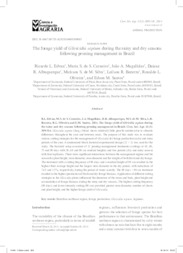The forage yield of Gliricidia sepium during the rainy and dry seasons following pruning management in Brazil.
The forage yield of Gliricidia sepium during the rainy and dry seasons following pruning management in Brazil.
Autoria: EDVAN, R. L.; CARNEIRO, M. S. de S.; MAGALHAES, J. A.; ALBUQUERQUE, D. R.; SILVA, M. S. de M.; BEZERRA, L. R.; OLIVEIRA, R. L.; SANTOS, E. M.
Resumo: Gliricidia sepium (Jacq.) Steud. shows relatively little growth variation due to climatic differences throughout the year and between years. The purpose of this study was to evaluate various cutting strategies for the management of Gliricidia for forage production in dry and rainy periods of the year. A randomized-block factorial experimental design (12 × 2) was used for the study. The factorial setup consisted of 12 pruning management treatments (cuttings at 45, 60, 75 and 90 days with 30, 60 and 90 cm residual heights) and two periods (dry and rainy season) with four replicates. There were significant interactions between the management regime and the season for plant height, stem diameter, stem diameter and the weight of both fresh and dry forage. The treatment with a cutting frequency of 90 days and a residual height of 90 cm resulted in the highest final average height and the largest stem diameter in the dry period, with reductions of 7.65 and 1.5%, respectively, during the period of water scarcity. The 90 days × 90 cm treatment resulted in the highest production of fresh and dry forage biomass. Application of different cutting strategies to the Gliricidia plants influenced the diameters of the stems and buds, plant height and accumulation of forage biomass during the rainy and dry seasons. The highest cutting frequency (90 days) and lower intensity cutting (90 cm) provided greater stem diameter, number of shoots and plant height, and the higher forage yield of Gliricidia.
Ano de publicação: 2014
Tipo de publicação: Artigo de periódico
Unidade: Embrapa Meio-Norte
Observações
1 - Por padrão são exibidas publicações dos últimos 20 anos. Para encontrar publicações mais antigas, configure o filtro ano de publicação, colocando o ano a partir do qual você deseja encontrar publicações. O filtro está na coluna da esquerda na busca acima.
2 - Para ler algumas publicações da Embrapa (apenas as que estão em formato ePub), é necessário ter, no celular ou computador, um desses softwares gratuitos. Sistemas Android: Google Play Livros; IOS: iBooks; Windows e Linux: software Calibre.
Acesse outras publicações
Acesse a Base de Dados da Pesquisa Agropecuária (BDPA) para consultar o acervo completo das bibliotecas da Embrapa.

